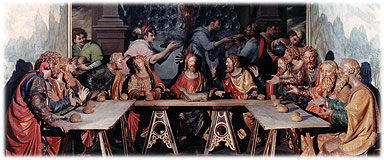
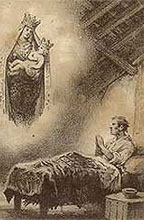
A young boy of Saronno, whose name was Pedretto, had been ill in bed for a number of years. He was healed miracolously by Our Lady of Strada Varesina who invited him to build a church in her honour.
After the building and the ruin of three small oratories on May 8, 1498 the first stone was posed and the building of the Sanctuary started.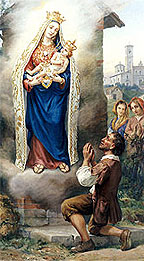
The project of the reinassance part of the church, including the tiburio, was made by Giovanni Antonio Amadeo, an important architect of the Milan Duomo, who also directed the works (1505). The clock tower was built between 1511 and 1516 on project and work of Paolo della Porta.
The great number of pilgrims showed that the church was too small; therefore the enlarging works on project of Vincenzo Seregni started in 1556. The new church was projected with a central nave and two lateral ones on five bays. Seregni himself directed the works up to the third bay.
The works stopped because the small chapel of Our Lady of the Miracles was to be demolished.
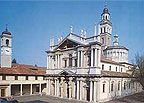
The prosecution of the building started again after the pastoral visit of San Carlo Borromeo in 1570. He wanted the Sanctuary to be completed. San Carlo was very devoted to the Virgin Mary and in 1581 he moved the sacred image from the first small chapel to the interior of the church. Pellegrino Tibaldi, alias il Pellegrini, assumed the direction of the final works. In 1578 he projected the magnificent façade. Its building, started in 1596 and ended in 1613, was directed by Lelio Buzzi and by Jacopo Borroni, architect in Saronno.
The superior part of the façade is a work of Carlo Buzzi in 1630. The small clock tower, which is above the building in the square was built in 1594.
The decoration of the interiors, after the first works, started with Bernardino Luini in 1525, with the two big frescos The Adoration of the Wise Men, the Presentation to the Temple and the Evangelists and the Doctors of the Church in the presbitery, with the Marriage of the Virgin in the presbitery and of the Dispute with the doctors in the anti-presbitery. Luini was back in 1531 to paint the four saints: Sebastian, Christopher, Antony abbot, and Rocco, on the lower part of the area under the dome. The works of Luini represents the one of the highest expressions of painting of the Lombardy sixteenth century.

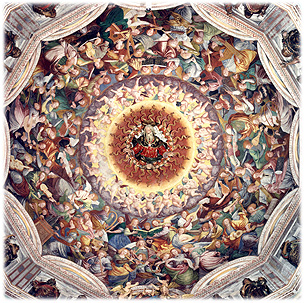
In the big cup of the dome (130 mq) the rejoicing Paradise welcoming the Assumption of the Virgin is represented in a fresco by Gaudenzio Ferrari (1535). The vast fresco represents 80 angels singing and playing with 50 instruments of the ancient times and higher 30 smaller angels dancing around the statue of the Eternal Father who, in open arms, welcomes the Virgin. This huge amazing scenic representation is painted with non common mastery which inspired many artists. Other painters worked in the Sanctuary: Cesare Magni who painted two saints, Martin and George, in 1534; Bernardino Lanino, disciple of Ferrari, with the webs of the dome (1545), Camillo and Giulio Cesare Procaccini with the pictures (1596), the painter from Saronno Stefano Maria Legnani, better known as il Legnanino, with the frescos on the walls of the lateral altars (1706). The friezes and decorations of Alberto Meleguli da Lodi are of a typical reinassance style with great richness of fine gold.
The wooden stautes of the niches and of the two groups of the Deposition and of the Last Supper were sculpted by Andrea da Milano (1529 - 1531). Other sculptors’ works are present as well: Giulio Oggioni (1535), Tomaso Bossi (1573), Gerolamo Prestinari (1598) and, more recently Pompeo Marchesi for the group of the Pietà (1820). In the big cloister the Nativity of Our Lord is painted, a work of great softness by Bernardino Luini (1525) and the door to the Quadreria – Museo is located.
